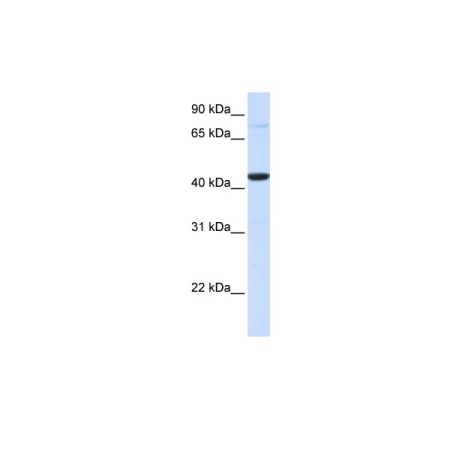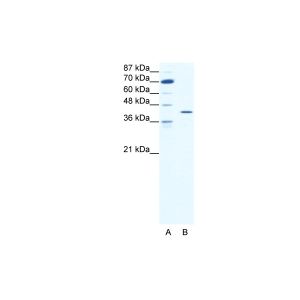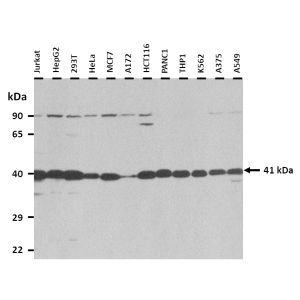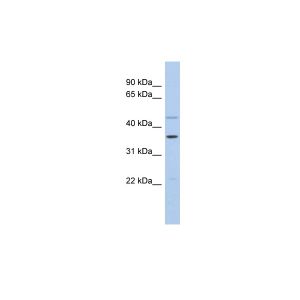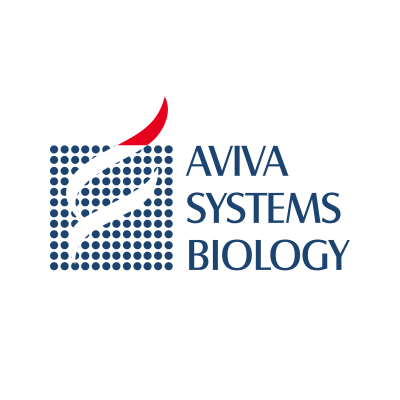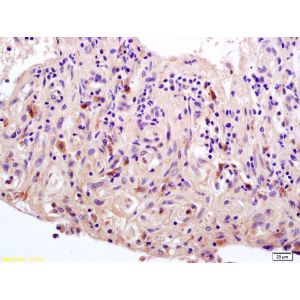FOS Antibody - middle region : Biotin
Katalog-Nummer P100626_P050-Biotin
Size : 100ul
Marke : Aviva Systems Biology
| Datasheets/Manuals | Printable datasheet for anti-FOS (P100626_P050) antibody |
|---|
| Tested Species Reactivity | Human |
|---|---|
| Predicted Species Reactivity | Human, Mouse, Rat, Cow, Dog, Pig, Sheep |
| Product Format | Liquid. Purified antibody supplied in 1x PBS buffer with 0.09% (w/v) sodium azide and 2% sucrose. |
| Clonality | Polyclonal |
| Host | Rabbit |
| Application | WB |
| Reconstitution and Storage | For short term use, store at 2-8C up to 1 week. For long term storage, store at -20C in small aliquots to prevent freeze-thaw cycles. |
| Immunogen | The immunogen is a synthetic peptide directed towards the middle region of human FOS |
| Purification | Affinity Purified |
| Predicted Homology Based on Immunogen Sequence | Cow: 100%; Dog: 100%; Human: 100%; Mouse: 92%; Pig: 100%; Rat: 92%; Sheep: 100% |
| Peptide Sequence | Synthetic peptide located within the following region: MSVASLDLTGGLPEVATPESEEAFTLPLLNDPEPKPSVEPVKSISSMELK |
| Concentration | 0.5 mg/ml |
| Blocking Peptide | For anti-FOS (P100626_P050) antibody is Catalog # AAP30916 (Previous Catalog # AAPP01640) |
| Reference | Seldeen,K.L., (2008) Arch. Biochem. Biophys. 473 (1), 48-60 |
|---|---|
| Gene Symbol | FOS |
| Gene Full Name | FBJ murine osteosarcoma viral oncogene homolog |
| Alias Symbols | p55, AP-1, C-FOS |
| NCBI Gene Id | 2353 |
| Protein Name | Proto-oncogene c-Fos |
| Description of Target | The Fos family consists of 4 members: FOS, FOSB, FOSL1, and FOSL2. The family members are leucine zipper proteins that can dimerize with proteins of the JUN family, thereby forming the transcription factor complex AP-1. As such, the FOS proteins have been implicated as regulators of cell proliferation, differentiation, and transformation. In some cases, expression of the FOS gene has also been associated with apoptotic cell death.The Fos gene family consists of 4 members: FOS, FOSB, FOSL1, and FOSL2. These genes encode leucine zipper proteins that can dimerize with proteins of the JUN family, thereby forming the transcription factor complex AP-1. As such, the FOS proteins have been implicated as regulators of cell proliferation, differentiation, and transformation. In some cases, expression of the FOS gene has also been associated with apoptotic cell death. Publication Note: This RefSeq record includes a subset of the publications that are available for this gene. Please see the Entrez Gene record to access additional publications. |
| Uniprot ID | P01100 |
| Protein Accession # | NP_005243 |
| Nucleotide Accession # | NM_005252 |
| Protein Size (# AA) | 380 |
| Molecular Weight | 41kDa |
| Protein Interactions | Psma4; CENPO; LMO3; ARFGAP1; USF2; USF1; PSMC5; PRKAA2; JUNB; JUN; GNG11; NQO1; ATF2; AQP1; LUZP4; CYTH4; CREB5; ABL1; CLU; ATP5I; APP; MTERF4; ANP32E; ARL6IP4; COPS4; CABP1; ZNF133; SET; NEFM; MAP1B; JUND; HSPA1A; MAF; FOS; DDIT3; CEBPG; CEBPE; CEBPA; AT |




